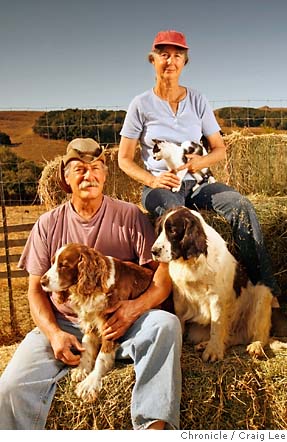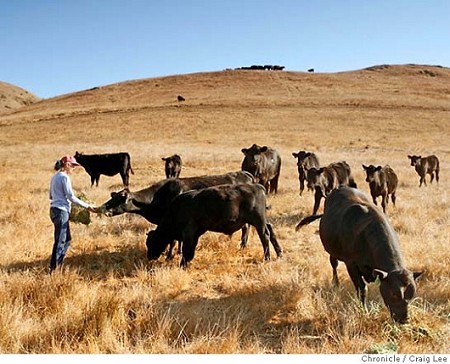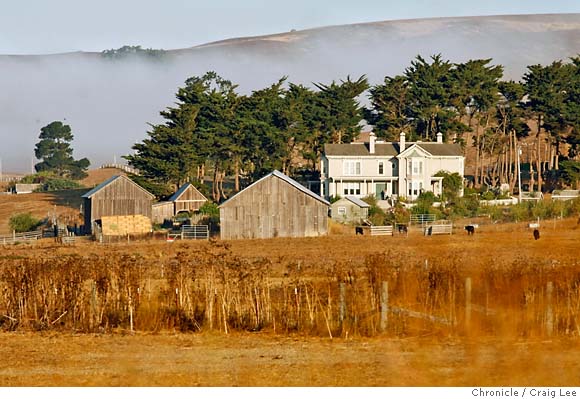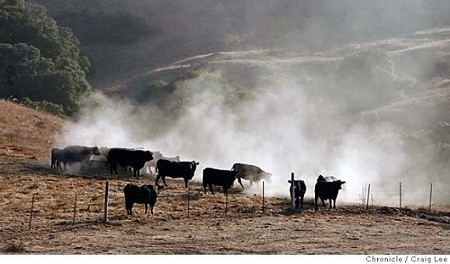Back to the ranch
Consumers are going to the source for pastured beef, pork, poultry and eggs
Wednesday, September 20, 2006
Jeff and Katie Hagan are never stuck wondering what's for dinner -- not with 80 pounds of beef in the freezer.
The San Francisco couple buy a quarter of a pastured steer at a time, frozen and neatly wrapped as roasts, steaks and burgers, plus oddball cuts never seen in an American supermarket -- ones they've learned the hard way whether to give a long braise or a fast sizzle.
Like a fast-growing number of American carnivores, the Hagans are opting out of the mega-feedlot meat system. They're buying directly from a local rancher or farmer who raises meat animals the old-fashioned way, on grassy pastureland.
In their case, the rancher is Joe Morris of Morris Grassfed Beef, a fifth-generation cattle rancher in San Juan Bautista (San Benito County). But it could just as easily be Mike and Sally Gale of Chileno Valley Ranch near Petaluma, or Fred Manas of Double-Bar-O Ranch in Esparto, or Mac Magruder in Mendocino County's Potter Valley.
They're just a few of the growing number of farmers and ranchers who are experiencing a surge in demand from consumers anxious to find good meat, humanely raised by people whose ranches they can visit and practices they can see first-hand, unlike mass-market meat.
And it's not just beef. Like Chez Panisse-inspired chefs before them, discerning eaters are scouring the countryside for local sources of pastured pork, lamb and chickens and their eggs.
These meats are almost impossible to find in stores. Until recently, farmers' markets have been a main source for home cooks, but supplies aren't reliable. And a quirk of federal law makes it much easier for ranchers and farmers to sell shares of whole animals directly to consumers.
So once a year, the Hagans drive over to the St. Francis Yacht Club parking lot in San Francisco's Marina, pop open their trunk and hang out with 15 or 20 other customers waiting for the big white Morris freezer truck to pull in.
"It's like a drug score -- if you're into food, this is as illicit as it gets," says Jeff Hagan, a 40-year-old investment banker.
The Hagans need a second freezer to handle their beef, but they had an old refrigerator in the garage anyway, and 80 pounds of meat fit neatly into its upper compartment. And Katie Hagan, 39, marketing director at Clorox, has had to pull out Bruce Aidells' "The Complete Meat Cookbook" to even identify some pieces before cooking them for Jeff and their three kids.
But going to all that trouble is well worth it.
"Cost-wise, we know it's really good," says Jeff Hagan. "It's great beef. And you don't have to worry about mad cow. And you're doing something environmentally better. And you don't have to worry about hormones for your kids -- so what's wrong with it?"
The phenomenon represents a convergence of recent food trends, especially the rise of grass-fed beef as a healthier, more environmentally sustainable and humane alternative to the big feedlot operations, and the move toward buying from local food producers.
Seeking out safer meat

This year, families like theirs will buy about 70 of the 200 head of black Angus cattle the Gales raise on their archetypal ranch -- 600 acres of old oaks and golden hillsides that have been in the family since an ancestor bought the land from the man who went east become Abraham Lincoln's interior secretary.
Many of their customers drive out to the ranch to pay a visit, even though their pickup point is miles away. Some pick their own apples in Mike's new orchard, bordered by Sally's roses. Some come to see exactly how the Gales treat their animals. One brought a chocolate cake.
Shea and Bennett like the ritual of going to the butcher shop, where they've gotten to know the butcher and "we're confident he's taking all the time he needs to not spill the intestines," Bennett says.
Because they buy a half-steer, they can tell the butcher exactly how they want their meat. Nowadays, they ask for the tougher cuts to be ground into hamburger, having learned that the lean, muscular grass-fed beef can be easy to dry out and long to tenderize.
"Half a cow is about eight full grocery bags," Bennett says. "It fills perfectly a 1.5-cubic-yard deep chest freezer."
Learning how to cook pastured meats can take practice, because it has less fat than grain-fed beef, and the composition of the fat is different. (See "Tips for cooking grass-fed beef," below right.)
"I've learned to marinate overnight with lots of tequila, cilantro and garlic," says Shea.
When it comes to braises and stews, the fact that she and Bennett run their insurance business from home turned out to be a stroke of culinary luck, because long and slow turned out to be the trick for tender meat. At 9 a.m., Shea tosses onions, broth and some chuck meat in a pot she can watch through the day; by dinner time, it's perfect.
Cuts dictate cooking

l Chileno Valley Ranch has seen demand for its beef rise pretty steadily since the Gales moved back from Hawaii in the late '90s and took over its ranching operation. Quickly, they realized that selling to feedlots in Idaho wasn't for them because they wanted better lives for their animals.
 Twin calves, which were too small for the broker and stuck around to graze over the winter, became the start of their pastured beef business. By spring, the steers had reached about 1,000 pounds apiece -- slaughter weight.
Twin calves, which were too small for the broker and stuck around to graze over the winter, became the start of their pastured beef business. By spring, the steers had reached about 1,000 pounds apiece -- slaughter weight.
"We decided to try to sell them to friends, by the quarter," says Gale. "People were pretty enthusiastic, so the next year we did 11."

Eventually they hope to peak at 90 to 100 a year, about all their land can handle.
"We're on a wave, and we're going to ride it as far as we can," says Mike Gale.
Raising animals on pasture takes time, so production numbers are rising slowly, but steadily, for all local producers, and many more are getting into the act, all over the country.
Online directory
Eatwild.com, the most comprehensive online directory of grass-fed ranches and farms selling directly to customers, now lists about 800, up from 40 in 2000, according to site director Jo Robinson, of Vashon Island, Wash. She estimates there are about 1,200 now.
The reason for buying quarters and halves has mostly to do with the thing people least like to think about when they're buying meat: slaughter.
To sell cut meat, whether it's beef, lamb or pork, ranchers have to send their animals through processing plants inspected by the U.S. Department of Agriculture. But the small slaughterhouses that once were common in ranch towns are fast disappearing as the meat industry has consolidated into four of five giant processors. And the big guys don't want to handle just a few animals at a time from small ranchers.
The Petaluma slaughterhouse that handles beef from Marin Sun Farms and other west Marin and Sonoma ranchers will shut down in 2008. The steers will have to take their last ride all the way to Orland, in Glenn County; as it is, lambs must go to a plant in Dixon.
But when people buy shares in a live animal, the rules are different.
Smaller state-inspected plants can handle them, and more cheaply than a USDA plant. Or, the animals can be slaughtered on the ranch -- the method used by the Gales -- and then the meat is sent to a butcher for two weeks of aging, cutting, wrapping and freezing.
The beauty of the system for a rancher like Mike Gale is that he doesn't have to keep track of orders for this many rib-eyes or that many short ribs -- and he doesn't end up with a surplus of unpopular cuts.
If you buy a quarter of a steer, you'll end up with about 100 or 125 pounds, including about 15 pounds of soup bones. Cuts from the front and rear quarters are mixed so no one gets all rump or all shoulder. The tail, liver and other organs aren't included unless people request them. "We eat a lot of tongue," says Mike Gale.
Most people buy a quarter, but some families go through two steers a year. They order first thing in the spring, when the selling season starts, and again in the fall, just before it trails off for the winter.
Demand for pork
The story is the same for pigs, and for lambs, which sell out instantly when they come of age in the spring.
Restaurants such as Oliveto in Oakland have helped create a market for pork raised the old-fashioned way by showcasing Willis Ranch pork from the Midwest.
TLC Ranch in Watsonville and Clark Summit Farm in Tomales, among others, are taking the idea local and finding a public hungry for full-fat, full-flavored pig raised the way pigs always used to be.
At TLC Ranch, Jim Dunlop says he'll raise about 100 Berkshire and Blue Butt pigs this year, moving them around his 10 acres so they can root around in the fields and sleep under the trees.
He sells the pigs by wholes or halves, and customers drive from as far away as San Francisco, Pleasanton and even Folsom for their meat. Because he uses a USDA slaughterhouse in Modesto, he can also sell cuts at Santa Cruz's Westside farmers' market.
"It's hard to find pork raised like this," he says.
He's also found a ravenous public appetite for pastured chickens and eggs. "I can't keep up," he says. "I could raise thousands and thousands of chickens and it wouldn't be enough."
Because the laws are different for chickens, he can slaughter on the ranch and sell through the farmers' market. He also sells them through the farm, and has established a drop-off point in Los Gatos.
Pastured chickens are tough to find in the Bay Area. Dave Evans at Marin Sun Farms, who sells pastured beef at the San Francisco Ferry Plaza Farmers Market and at his small store in Point Reyes Station, sells a few pastured chickens. People order through his Web site, and pick up at the farmers' market.
Evans is building his pastured beef herd, but doesn't sell many in quarters and halves. He goes through USDA processing so he can sell to restaurants and maintain his farmers' market presence.
Quarter- and half-animal sales remain a niche market. Not everyone has room for a quarter of a steer next to the Haagen-Dazs in the freezer, or has the money or the space for a second freezer.
"Even a quarter of a beef can be a scary amount," Evans says.
In some areas, buying clubs have formed to buy pastured meats, including one in Berkeley for followers of Weston A. Price nutritional precepts, which revolve around traditionally raised meats.
Informally, friends are banding together too. But splitting up the meat can be problematic -- who gets the filet mignon and who gets the rump roast?
Bonnie Azab Powell of Oakland, who recently co-founded a new Web site for conscious eaters, the Ethicurean (www.ethicurean.com), spends considerable time scoping out pastured meat sources and knows she could round up 20 friends to go in on a whole steer.
But she longs for a better alternative: a meat CSA, modeled after the popular produce subscriptions, called community-supported agriculture, where small farms deliver weekly boxes of fruit and vegetables to urban drop-off points.
"I would like to get something every other week, with a little beef, pork, lamb and poultry," says Powell, a.k.a. Dairy Queen on her Ethicurean site. A born-again carnivore and a UC Berkeley public affairs writer, Powell and five friends started the Ethicurean after getting what she calls religion around food from Michael Pollan's writings.
Two meat CSAs recently started in the Seattle area, and one that distributes pastured meats from several small farms in upstate New York to Manhattan has been operating for several years. So far there's nothing like it in the Bay Area. But that could be changing.
Dividing it up
Morris Grassfed Beef is experimenting with quarterly deliveries, so people who buy a half or quarter steer would only have to deal with about 20 or so pounds at a time.
In another approach, Yolo County pastured beef rancher Fred Manas says a group of small ranchers wants to put a USDA plant near his Esparto ranch, with freezer-lockers where big-city customers could keep their quarters and halves, picking up a few dinners' worth at a time.
"What we feel is there's a heck of a demand," says Manas.
The Dairy Queen agrees: "I think there's a movement happening, and it's just getting started."
Tips for cooking grass-fed beef
Most of the beef sold directly to home cooks by Northern California ranchers and farmers is entirely, or mostly, grass-fed. And that provides some challenges to cooks used to roasting, braising and grilling fatty grain-fed beef.
Leaner meat. Mainly, grass-fed beef is much, much leaner and has fewer calories.
The rule of thumb is that grass-fed beef contains about the same amount of fat as skinless chicken breast, which means that a 6-ounce steak has 100 fewer calories than a grain-fed steak. But the amount of fat and calories can vary from animal to animal.
What fat there is in grass-fed beef contains less saturated fat and more healthful polyunsaturates, plus it contains more "conjugated linoleic acid" or CLA, another so-called good fat, than is present in grain-fed beef.
In the mix are beneficial fats called omega-3 fatty acids. But Palo Alto food scientist Harold McGee says the amount is so small, "if you ate one walnut while you wait for your meat to cook, you'd get lots more omega-3s."
Cook it differently. Instead of fat, grass-fed meat contains moisture, which heats more quickly than fat. So it is easy to overcook unless you pay close attention, according to Mike and Sally Gale of Chileno Valley Ranch.
Grass-fed meat should be cooked to a lower internal temperature because it will keep cooking even off the heat. If cooked past medium-rare, it dries out and can become tough -- unless, as with a low-temperature braise, it's cooked long enough to tenderize the meat.
Because the beef isn't raised in crowded feedlot conditions that encourage the growth of lethal E. coli bacteria, ranchers say their pastured meat doesn't need to be cooked to well-done, as federal food safety guidelines recommend.
More tips. Here are a few other suggestions for preparing grass-fed beef:
-- With a steak, be sure to marinate. Cook it over a very hot fire, and cook it fast, just a few minutes on each side, says Sally Gale. Then take it off the heat, set it aside and let it finish cooking. Never cook it past medium-rare. Mike Gale cuts into the meat to check its doneness.
-- With a roast, a crust on the outside helps seal in juices. See recipe on page F5, or use a simple flour-herb-water paste. Start the meat in a hot, 400° oven to form the crust, then turn the heat down low, to about 300°, after 10 minutes. Cook only to an internal temperature of 125°, 15 degrees below rare on most meat thermometers; it will continue cooking out of the oven.
-- With a braise or stew, start in a hot oven (400°) but turn the heat down after 10 minutes, to 275° (if your oven runs a bit hot) or 300° (if it runs a bit cool). Ideally, the braising liquid will evaporate steadily. Some home cooks have found they need to braise grass-fed meats much longer than grain-fed; you may need to experiment. -- Carol Ness
Finding pastured meat
Online resources
Eatwild.com, lists about 800 U.S. ranches and farms selling pastured meats directly to customers. California link is www.eatwild.com/products/california.html.
Also, state-by-state "Beyond the Farm" section lists buying clubs, stores and restaurants selling grass-fed meats; for California's, go to www.eatwild.com/products/californiaresources.htm.
Localharvest.org links to thousands of small and organic food producers, including meat and poultry operations. Searchable by map or product sought.
Ranches and farms
Here are a few of the farms and ranches selling beef, pork, lamb, rabbits or poultry directly to Bay Area customers:
Chileno Valley Ranch, west of Petaluma in Marin County. Mike and Sally Gale. Quarters, halves and wholes of black Angus beef raised on 600 acres; feed supplemented with hay and alfalfa. (707) 765-6664; www.chilenobeef.com.
Clark Summit Farm, Tomales. Liz Cunninghame and Dan Bagley. Small quantities of grass-fed and grass-finished beef, pastured pork, chicken, turkeys and eggs. (707) 876-3516; e-mail clarksummitfarm@aol.com. See www.eatingwild.com listing.
Devil's Gulch Ranch, Nicasio. Mark Pasternak. Small amounts of pork, spring lamb and rabbit when available. Summer agricultural camp for kids. (707) 953-0923; www.devilsgulchranch.com.
Deep Roots Ranch, Watsonville. Lamb, chickens, eggs; sold out for this year. (831) 359-5997 or e-mail jalysonh@yahoo.com; localharvest.org/farms/M14377.
Double-Bar-O Angus Ranch, Esparto, Yolo County. Fred Manas. Pastured Angus beef, supplemented with alfalfa pellets, almond hulls, rice bran and corn; sold by quarter, half or whole; sold out for this year. (530) 787-3228; www.doublebaroangus.com.
Magruder Ranch (Inglehaven Ranch), Potter Valley, Mendocino County. Mac Magruder. Pastured beef, fed hay in winter; sold by quarter, half or whole; also to Chez Panisse and other restaurants, and through Woodland Market in Kentfield. (707) 743-1539; e-mail Magruderranch@pacific.net.
Marin Sun Farms, Point Reyes. Dave Evans. Pastured beef and chickens, sold by quarter, half or whole; beef also sold retail at San Francisco Ferry Plaza Farmers Market and Bi-Rite Market in San Francisco; and to local restaurants. (415) 663-8997; www.marinsunfarms.com.
Morris Grassfed Beef, San Juan Bautista, Julie and Joe Morris, T.O. Cattle Co. Quarters, halves and wholes of pastured beef, $6-$6.30 a pound. Yearly drop-offs in San Francisco, Berkeley, San Jose and Fairfield. (831) 623-2933; www.morrisgrassfed.com.
TLC Ranch, Watsonville, Jim Dunlop and Rebecca Thistlethwaite. Chickens; Tamworth, Berkshire and Blue Butt pigs, sold by quarter, half or whole. Santa Cruz Westside farmers market; pickup at the ranch; drop-off in Los Gatos. (209) 505-4558; localharvest.org/farms/M8962.
Marinated Grass-Fed Flank Steak
Use any marinade or this Food staff favorite, Bi-Rite Market kitchen manager Eduardo Martinez's carne asada marinade. Mike Gale's tricks for tenderness: Marinate overnight, cook on a hot grill and don't cook too long.
INGREDIENTS:
1 1/2 teaspoons salt
1/2 teaspoon whole coriander seeds
1/2 teaspoon whole cumin seeds
1 1/2 tablespoons ground ancho chile powder
Pinch hot red pepper flakes
1/4 cup olive oil
2 pounds flank, hanger or other thin steak
Pepper to taste
INSTRUCTIONS:
Rub salt into both sides of the meat. Toast coriander and cumin in a skillet over medium heat until fragrant, around 5-8 minutes. Let cool, then grind in a spice grinder. Combine with ancho chile, pepper flakes, olive oil and pepper, stir, then coat meat with it. Cover and refrigerate overnight.
Grill over a very hot fire, checking often for doneness. Remove when rare or medium-rare; grass-fed beef cooks faster than grain-fed beef and continues cooking off the flame. Mike Gale likes to cut off a small bit every so often to check doneness. Let rest a few minutes when it comes off the grill.
Serves 6-8
Nutritional standards for grass-fed beef have not been established. But grass-fed contains more protein, less fat, less saturated fat and less cholesterol than grain- or corn-fed beef.
Sally Gale's Olive-Crusted Rib Roast
To save prep time, you can skip the step involving breadcrumbs and fat; just continue roasting until the roast hits an internal temperature of 125°. Gale loves garlic, so she often adds more.
INGREDIENTS:
6 ounces pitted black or kalamata olives
3 cloves garlic
4 anchovy fillets
2 4-inch sprigs rosemary, leaves only
Red wine as needed
3 1/2- to 4- pound standing rib roast
Freshly ground pepper
3/4 cup fresh bread crumbs
1/2 teaspoon minced fresh rosemary
Olive oil as needed
12 baguette slices, toasted (optional)
INSTRUCTIONS:
Pulse olives, 2 cloves of the garlic, anchovies and rosemary leaves in a food processor; keep pulsing and add enough red wine to make a smooth paste.
Score the fatty side of the roast in a diamond pattern, cutting only the fat but not the meat. Put roast in a shallow pan, bone side down. Smear the top and sides of the roast with the olive paste. Season with pepper. Let stand at room temperature for 30-45 minutes while you pre-heat oven to 400°.
Roast for 10 minutes, then turn oven down to 300° and continue roasting to an internal temperature of 115°, about 1 hour and 40 minutes. (If you are skipping the breadcrumb step that follows, leave in the oven and roast for about 20 minutes more, until the meat reaches 125°, then remove from oven.)
Pulse the breadcrumbs in a food processor with the remaining clove of garlic and 1/2 teaspoon of rosemary. Take the roast from the oven, pat the breadcrumbs on the top, spoon fat from the pan over the breadcrumbs. If you don't have enough fat in the pan, add some olive oil.
Put roast back in the oven and cook for 20 more minutes or until the meat thermometer reaches 125°. That's about 15 degrees below "rare" on most meat thermometers, but the meat will keep cooking.
Remove from oven, tent with foil and let the meat stand for 15 minutes before carving.
If you like, dip baguettes slices in juices or smear with leftover olive paste and serve with the meat.
Serves 8
Nutritional standards for grass-fed beef have not been established. But grass-fed contains more protein, less fat, less saturated fat and less cholesterol than grain- or corn-fed beef.
INGREDIENTS:
2 tablespoons olive oil, or more as needed
2 1/2 pounds of beef stew meat, cut in 3/4- to 1-inch chunks
1/2 cup flour
1 large onion, chopped
5 fat garlic cloves, chopped or whole
1 cup red wine
6-inch sprig fresh rosemary
4 fresh sage leaves
4 sprigs fresh oregano
2 sprigs thyme, leaves only
Salt and ground pepper, to taste
INSTRUCTIONS:
Preheat oven to 400°.
Heat 2 tablespoons olive oil in a heavy, ovenproof pot that has a lid. Dredge beef chunks in flour, then brown in the medium-hot oil, slowly, until browned on all sides. Remove meat from pan, and add a little more oil if needed. Add onion and garlic and cook gently until translucent and starting to brown; be careful not to burn. Remove onion/garlic mix from the pot. Put meat back in, add onion and garlic on top. Add wine and enough water to reach almost to the top of the meat. Add the rosemary sprigs, sage leaves and oregano, and sprinkle the thyme leaves, salt and pepper over the top.
Cover the pot and place in 400° oven; after 10 minutes, turn the heat down to 300°, or 275° if your oven runs hot. Cook until the level of the liquid drops by 1/2-inch or so, leaving a glaze over exposed meat, about 3 hours; check every 45 minutes to be sure the level is dropping, but not too much.
Pick out the herb sprigs and serve.
Serves 4-6
Nutritional standards for grass-fed beef have not been established. But grass-fed contains more protein, less fat, less saturated fat and less cholesterol than grain- or corn-fed beef.
E-mail Carol Ness at cness@sfchronicle.com.
Page F - 1
URL: http://sfgate.com/cgi-bin/article.cgi?file=/c/a/2006/09/20/FDG7LL5N221.DTL



